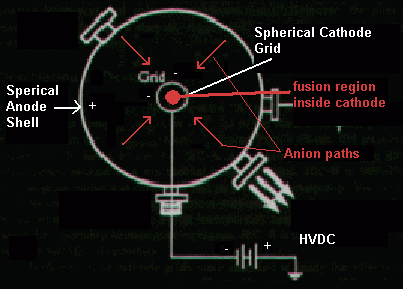Inertial Electrostatic Confinement
What it Is, How it Works
Dr. George Miley's (University of Illinois) IEC-GD Device [3]

To use Farnsworth's description of the process:
" The trajectories or the charged particles are determined .by the composite
field or poissor [italics added] which is produced by the aggregate of
the fields of the oppositely charged particles. When a positively charged
particle (ion) of zero velocity falls from a point just inside a virtual
anode (which defines a spherical positive potential boundary) it is accelerated
toward the adjacent virtual cathode and, in passing beyond it decelerates
toward a condition of zero velocity at an equipotentiaI boundary of that
from which it started, and then repeats this velocity rate of change from
zero to maximum, and then again to maximum in the opposite direction. Electrons
likewise will oscillate through virtual anodes between negative equipotential
barriers. Since one polarity of charged particle approaches its maximum
velocity while the other polarity approaches its minimum, the two species
maintain their separate identities and spaced charges. Hence, it is seen
that the particles are trapped inertially between such equipotential boundaries;
accordingly, I call my method for containing the nuclear-fusion reacting
particles "inertial containment." The ions which are created on the inward
sides of the boundaries of the spherical virtual anodes and which oscillate
through or near the center of the device produce the required density thereat
to satisfy the conditions for a self-sustaining nuclear fusion reaction.
Thus, the charged particles are literally compressed into the required
density in the central region by the process of inertial containment, and
the present device utilizes this process." [4]



